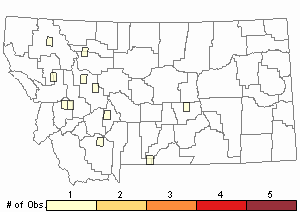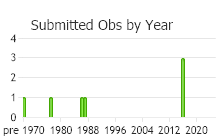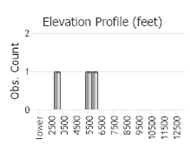View in other NatureServe Network Field Guides
NatureServe
Montana
Utah
Wyoming
Idaho
Wisconsin
British Columbia
South Carolina
Yukon
California
New York
A Fern Moss - Hypnum cupressiforme
General Description
Plants: Pleurocarpous, growing in shiny, interwoven mats (Lawton 1971), light green, or green with russet, gold or yellow tones. Stems prostrate to upright, erratically pinnate to branching little, 1-8 cm or more (FNA 2014), the apices frequently hooked (Lawton 1971), light green, sometimes with yellow tones, turning brown over time; branches 1-3 cm in length; hyalodermis lacking and central strand weakly formed; pseudoparaphyllia composed of filaments (FNA 2014), few (Crum and Anderson et al. 1981); cortical stem cells tiny and with thick walls (Lawton 1971).
Stem Leaves: Overlapping, sometimes curved in sickle-like fashion and turned in one direction, 1.5-2 mm in length, to 0.8 mm in width (FNA 2014), cupped (Lawton 1971), egg-shaped to lance-shaped and somewhat rectangular, slowly or suddenly tapering to the narrow acumen, the base not extending down the stem; leaf edges flat or curved back and down near the base, finely saw-toothed above, sometimes faintly so or almost smooth; costa paired and short or faint; branch leaves akin to stem leaves (FNA 2014).
Leaf Cells: Upper laminal cells narrowly diamond-shaped and frequently thick-walled (Crum and Anderson et al. 1981), not papillose; medial laminal cells longer and narrower than the basal cells; basal laminal cells uncolored and the walls nonporose; alar cells somewhat transparent or colored yellow to brown, the lowermost cells bigger, the area distinctly delineated (FNA 2014).
Hypnum cupressiforme var. cupressiforme: Present in Montana. Stems nearly upright or bending downward, 1-3 cm in length, the leaves typically curved to very curved, the branch leaves about 1-2 mm or more in length, the edges nearly smooth to toothed above, the alar cells neither colored nor concave (FNA 2014).
Hypnum cupressiforme var. filiforme: Stems prostrate, 2-6 cm in length, the leaves a little curved to straight, the branch leaves about 1-1.4 mm in length or a little smaller, slowly tapering to the apex, the margins smooth or nearly so (FNA 2014).
Hypnum cupressiforme var. julaceum: Stems prostrate to upright, about 5 cm in length, the branch leaves 1-1.4 mm in length or a little smaller, suddenly constricted at the apex, the margins smooth or nearly so (FNA 2014).
Hynum cupressiforme var. subjulaceum: Stems prostrate, 5-8 cm or more in length, the leaves a little curved to straight, the branch leaves 1.5-2 mm or more in length, the alar cells colored and concave (FNA 2014).
Phenology
Variety cupressiforme: Fruit ripens in spring (FNA 2014).
Varieties filiforme, julaceum, and subjulaceum: Fruit maturation time unknown (FNA 2014).
Diagnostic Characteristics
Dependable characteristics in most Hypnum species are inconstant in this highly polymorphic species ascribed with more than 60 varietal descriptions to date (FNA 2014).
The cupped leaves cause the reflecting light to create an unusual “satin sheen” or greyish cast on the plants (Crum and Anderson et al. 1981).
The most dependable distinguishing characteristic of the similar Hypnum vaucheri may be its leafy pseudoparaphyllia with dull ends; those of H. cupressiforme are lance-shaped to filamentous (FNA 2014).
Range Comments
North American Range
Variety cupressiforme: In Canada from YT to NU, BC to NL and NS; in the USA in AK, WA, MT, CO, SD, TX, IA, AR, IL, WI to PA and ne to ME, also NC; and in Mexico (FNA 2014). Known in Montana from Broadwater, Choteau, Flathead, Granite, Lake, Lincoln, and Park Counties (Elliott and Pipp 2016).
Variety filiforme: In Canada from NB, NS and PE; in the USA in OK, TX, AR, TN, NC, and VA, MI to PA and ne to ME (FNA 2014).
Variety julaceum: In Canada from YT to NT, in the USA from AK and CO (FNA 2014).
Variety subjulaceum: In Canada from YT to BC, in the USA in AK, CO and NM, and ND (FNA 2014).
Observations in Montana Natural Heritage Program Database
Number of Observations: 12
(Click on the following maps and charts to see full sized version)
Map Help and Descriptions
Relative Density

Recency



 (Observations spanning multiple months or years are excluded from time charts)
(Observations spanning multiple months or years are excluded from time charts)
Habitat
Variety cupressiforme: Tree bases and decaying wood (Elliott and Pipp 2016), stone. Occurring from lowlands to about 13,120 feet elevation (FNA 2014).
Variety filiforme: Sheer bluff faces and on trees. Occurring from lowlands to about 8200 feet elevation (FNA 2014).
Variety julaceum: Level faces in brightly lit areas, particularly in mountains and northerly latitudes. Occurring from lowlands to about 8200 feet elevation (FNA 2014).
Variety subjulaceum: Ledges of bluffs and level stone faces, in open and protected habitats, typically on basic surfaces. Occurring from lowlands to about 13,120 feet elevation (FNA 2014).
Reproductive Characteristics
Dioicous. Exterior perichaetial bracts bent back and downward; interior perichaetial bracts upright with a thin acumen, finely saw-toothed above. Seta 10-30 mm tall, somewhat red, smooth. Capsule 1.8-2.8 mm in length, somewhat red, a little tilted (FNA 2014), bowed to some extent, not shrunken below the opening when dry (Lawton 1971);operculum cone-shaped to beaked; exostome teeth 16, with a zigzag line on the outer face, fine lines or ridges below, and papillae above; endostome processes 16, similar in height as the teeth, keeled, cilia present. Calyptra hairless and draping hood-like (FNA 2014).
Stewardship Responsibility
References
- Literature Cited AboveLegend:
 View Online Publication
View Online Publication Crum, H.A. and L.E. Anderson. 1981. Mosses of Eastern North America. 2 volumes. Columbia University Press, New York. 1328 pp.
Crum, H.A. and L.E. Anderson. 1981. Mosses of Eastern North America. 2 volumes. Columbia University Press, New York. 1328 pp. Elliott, J.C. and A.K. Pipp. 2018. A Checklist of Montana Mosses (1880-2018). Updated 3 January, 2020. Montana Natural Heritage Program, Helena, Montana. 73 pp.
Elliott, J.C. and A.K. Pipp. 2018. A Checklist of Montana Mosses (1880-2018). Updated 3 January, 2020. Montana Natural Heritage Program, Helena, Montana. 73 pp. Flora of North America Editorial Committee, eds. 2014. Flora of North America North of Mexico. Volume 28. Bryophytes: Mosses, Part 2. Oxford University Press, Inc., NY. xxi + 702 pp.
Flora of North America Editorial Committee, eds. 2014. Flora of North America North of Mexico. Volume 28. Bryophytes: Mosses, Part 2. Oxford University Press, Inc., NY. xxi + 702 pp. Lawton, E. 1971. Moss Flora of the Pacific Northwest. Hattori Botanical Laboratory. Japan: Yamabuki-cho, Shinjuku-ku, Tokyo. 362 pages plus appendices.
Lawton, E. 1971. Moss Flora of the Pacific Northwest. Hattori Botanical Laboratory. Japan: Yamabuki-cho, Shinjuku-ku, Tokyo. 362 pages plus appendices.
- Additional ReferencesLegend:
 View Online Publication
View Online Publication
Do you know of a citation we're missing? Elliot, J. C. 1993. Second checklist of Montana mosses. Unpublished report. U.S. Forest Service, Region 1. Missoula, MT. 45 pp.
Elliot, J. C. 1993. Second checklist of Montana mosses. Unpublished report. U.S. Forest Service, Region 1. Missoula, MT. 45 pp. Lawton, E. 1971. Keys for the Identification of the Mosses on the Pacific Northwest. Reprinted from 'Moss Flora of the Pacific Northwest'. Published as Supplement No. 2 of the Journal of the Hattori Botanical Laboratory. Nichinan, Miyazaki, Japan. 66 pp.
Lawton, E. 1971. Keys for the Identification of the Mosses on the Pacific Northwest. Reprinted from 'Moss Flora of the Pacific Northwest'. Published as Supplement No. 2 of the Journal of the Hattori Botanical Laboratory. Nichinan, Miyazaki, Japan. 66 pp. Smith, A.J.E. 1980. The Moss Flora of Britain and Ireland. Cambridge University Press, Cambridge. 705 pp.
Smith, A.J.E. 1980. The Moss Flora of Britain and Ireland. Cambridge University Press, Cambridge. 705 pp.
- Web Search Engines for Articles on "A Fern Moss"





